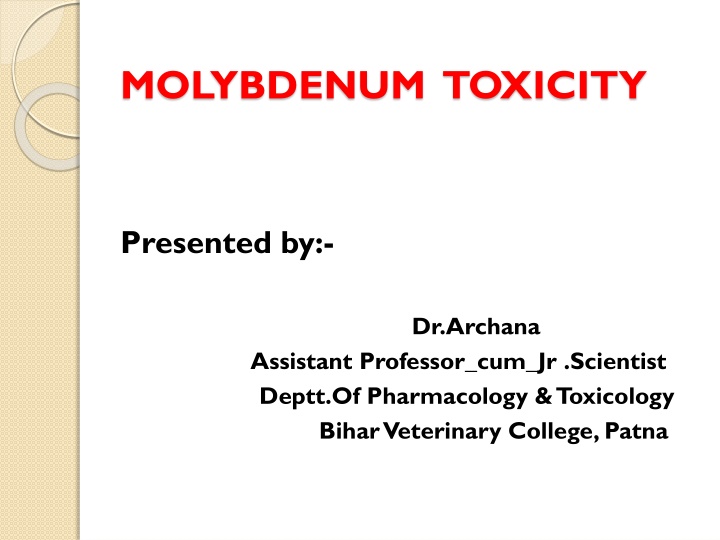
Molybdenum Toxicity: Sources, Mechanism, Clinical Signs, and Treatment
Explore the sources, toxicokinetics, mechanism of toxicity, clinical signs, and treatment options for molybdenum toxicity. Learn about its impact on animals and the importance of maintaining a balanced diet to prevent toxicity.
Download Presentation

Please find below an Image/Link to download the presentation.
The content on the website is provided AS IS for your information and personal use only. It may not be sold, licensed, or shared on other websites without obtaining consent from the author. If you encounter any issues during the download, it is possible that the publisher has removed the file from their server.
You are allowed to download the files provided on this website for personal or commercial use, subject to the condition that they are used lawfully. All files are the property of their respective owners.
The content on the website is provided AS IS for your information and personal use only. It may not be sold, licensed, or shared on other websites without obtaining consent from the author.
E N D
Presentation Transcript
MOLYBDENUM TOXICITY Presented by:- Dr.Archana Assistant Professor_cum_Jr .Scientist Deptt.Of Pharmacology & Toxicology Bihar Veterinary College, Patna
Content of chapter * Sources * Toxicokinetic * Mechanism of toxicity * Clinical Signs * Treatment
Molybdenum Toxicity Molybdenum (Mo) is an essential nutrient in plants and animals. In plants and microbes, reduction of nitrate to nitrite and nitrogen fixation requires Mo. Higher animals require Mo for oxygen transfer reactions of aldehyde oxidase, sulfite oxidase, and xanthine oxidase, where Mo is bound to a pterin nucleus. In feed of cattle Copper : Molybdenum ratio of 6:1 is considered ideal.
Source :- Mo is commonly found in low concentrations in most dietary constituents, but excess intake can occur from plants grown on soils naturally high in Mo. Dressing of Pasteur with Sodium-Molybdate Deficient dietry intake of copper. Drinking water from the source which are polluted with industrial effluents.
Toxicokinetic Molybdenum compounds are both rapidly absorbed and excreted. The storage is transient and through the body but is greatest in kidney and bones. The retention or excretion of molybdenum is affected by the amount of copper and sulphate in the diet. Increase Sulphate intake promotes the excretion of large quantities of Mo, particularly in the urine and the level of Mo in the blood falls.
Mechanism of toxicity The primary mechanisms by which Mo cause toxicity are directly tied to its interactions with sulfur and copper. These interactions result in functional disturbance or copper deficiency symptoms . The reducing environment of the rumen converts sulfate or sulfur from sulfur-containing amino acids to sulfide, which then forms mono-, di-, tri-, and tetra-thiomolybdates. Thiomolybdates bind to copper in the digestive tract & prevents absorption of copper, resulting into a state of Cu deficiency. Hypochromic anaemia is characteristic. Persistent scouring with passage of liquid faeces full of gas bubbles (teart) could be due to complex formation between molybdenum and catechols, which like other phenols, are bacteriostatic and control the activity of bacteria in the gut.
Clinical Sign Most clinical signs of chronic Mo poisoning are associated with induced copper deficiency. The first clinical sign of chronic Mo poisoning is severe diarrhea. Teart is used to refer to soil or plants that contain unusually high amounts of Mo, thus the term teart scours is commonly used to describe the diarrhea associated with excessive Mo intake. Depigmentation of hair coat, noticiable in black animalspecially around eye. Hypochromic anaemia, Joint pain, Osteoporosis, and decresed fertility. Sheep and young animal show stiffness of the back and legs with reluctance to rise this condition is called Enzootic ataxia in Australia and Swayback disease in the UK.
Treatment The two primary mechanisms of treating Mo toxicosis involve removal from the source of high Mo and copper supplementation. Scouring can be controlled by daily administration of Copper sulphate 1gm for calves and 2 gm. For cattles. Copper glycinate injection S/C @ of 60mg. For calves and 2 0f 120m mg. for cattle can be given as an adjunct therapy.
